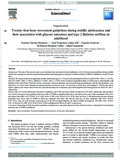Mostrar el registro sencillo del ítem
Twenty-four-hour movement guidelines during middle adolescence and their association with glucose outcomes and type 2 diabetes mellitus in adulthood
| dc.creator | García Hermoso, Antonio | es_ES |
| dc.creator | López Gil, José Francisco | es_ES |
| dc.creator | Ezzatvar, Yasmin | es_ES |
| dc.creator | Ramírez Vélez, Robinson | es_ES |
| dc.creator | Izquierdo Redín, Mikel | es_ES |
| dc.date.accessioned | 2022-11-07T14:25:11Z | |
| dc.date.available | 2022-11-07T14:25:11Z | |
| dc.date.issued | 2022 | |
| dc.identifier.citation | García-Hermoso, A., López-Gil, J. F., Ezzatvar, Y., Ramírez-Vélez, R., & Izquierdo, M. (2022). Twenty-four-hour movement guidelines during middle adolescence and their association with glucose outcomes and type 2 diabetes mellitus in adulthood. Journal of Sport and Health Science, S2095254622000850. | en |
| dc.identifier.issn | 2095-2546 | |
| dc.identifier.uri | https://hdl.handle.net/2454/44281 | |
| dc.description.abstract | Background: The aim of the present study was to determine the association between adherence to the 24-h movement guidelines during middle adolescence and glucose outcomes (glycated hemoglobin and fasting glucose) and type 2 diabetes mellitus (T2DM) in adulthood, 14 and 22 years later. Methods: We analyzed data from apparently healthy adolescents aged 12-18 years who participated in Waves I and II (1994-1996, n = 14,738), Wave IV (2008-2009, n = 8913), and Wave V (2016-2018, n = 3457) of the National Longitudinal Study of Adolescent to Adult Health (Add Health) in the United States. Physical activity, screen time, and sleep duration were measured using questionnaires, and the 24-h guidelines were defined as: 5 or more times moderate-to-vigorous physical activity per week, ≤2 h per day of screen time, and sleeping 8-10 h per day and or night. Capillary and venous whole blood was collected and analyzed to determine glycated hemoglobin and fasting glucose for Waves IV and V, respectively. Results: Only 2.1% of the adolescents met all the 3 guidelines, and 37.8% met none of them. In both waves IV and V, adolescents who met physical activity and screen time guidelines had lower odds of T2DM in adulthood than those who did not meet any of these guidelines (Wave IV; prevalence ratio (PR) = 0.57, 95%CI: 0.21-0.89; Wave V: PR = 0.43, 95%CI: 0.32-0.74). Only for Wave V did adolescents who met all three guidelines have lower odds of T2DM at follow-up compared with those who did not meet any of these guidelines (PR = 0.47, 95%CI: 0.24-0.91). Also, for each increase in meeting one of the 24-h recommendations, the odds of T2DM decreased by 18% (PR = 0.82, 95%CI: 0.61-0.99) and 15% (PR = 0.85, 95%CI: 0.65-0.98) in adulthood for Waves IV and V, respectively. Conclusion: Promoting all 24-h movement guidelines in adolescence, especially physical activity and screen time, is important for lowering the potential risk of T2DM in adulthood. | en |
| dc.description.sponsorship | AGH is a Miguel Servet Fellow (Instituto de Salud Carlos IIIFSE - CP18/0150). JFLG is a Postdoctoral Fellow (Universidad de Castilla-La Mancha - ID 2021-UNIVERS-10414). | en |
| dc.format.mimetype | application/pdf | en |
| dc.language.iso | eng | en |
| dc.publisher | Elsevier | en |
| dc.relation.ispartof | Journal of Sport and Health Science, 2022,1-13 | en |
| dc.rights | This is an open access article under the CC BY-NC-ND license | es_ES |
| dc.rights.uri | http://creativecommons.org/licenses/by-nc-nd/4.0/ | en |
| dc.subject | Glucose metabolism | en |
| dc.subject | Glycated hemoglobin | en |
| dc.subject | Physical activity | en |
| dc.subject | Screen time | en |
| dc.subject | Sleep duration | en |
| dc.title | Twenty-four-hour movement guidelines during middle adolescence and their association with glucose outcomes and type 2 diabetes mellitus in adulthood | en |
| dc.type | Artículo / Artikulua | es |
| dc.type | info:eu-repo/semantics/article | en |
| dc.date.updated | 2022-11-04T11:59:25Z | |
| dc.contributor.department | Ciencias de la Salud | es_ES |
| dc.contributor.department | Osasun Zientziak | eu |
| dc.rights.accessRights | Acceso abierto / Sarbide irekia | es |
| dc.rights.accessRights | info:eu-repo/semantics/openAccess | en |
| dc.identifier.doi | 10.1016/j.jshs.2022.08.001 | |
| dc.relation.publisherversion | https://doi.org/10.1016/j.jshs.2022.08.001 | |
| dc.type.version | Versión publicada / Argitaratu den bertsioa | es |
| dc.type.version | info:eu-repo/semantics/publishedVersion | en |



